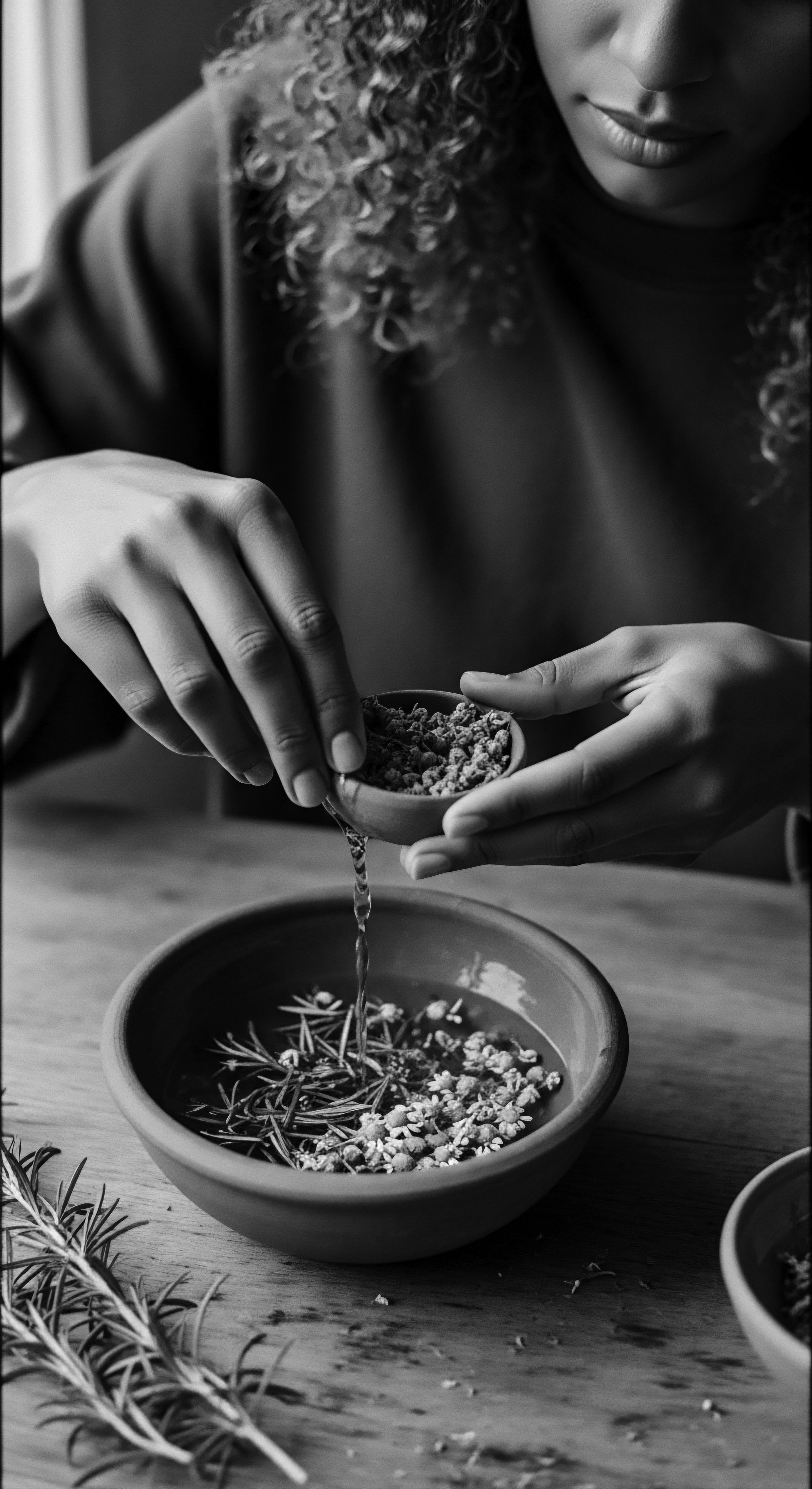
Fundamentals
The exploration of Natural Hair Ingredients begins not in sterile laboratories, but in the verdant embrace of ancestral lands, within the intimate spaces of familial care, and amidst the resilient spirit of communities whose very existence was intertwined with the earth’s offerings. To comprehend the designation of Natural Hair Ingredients, particularly as it relates to textured hair, one must first listen for the echoes from the source, tracing a lineage of understanding that predates modern commerce. This initial delineation is a gentle invitation to perceive these elements not merely as raw materials, but as venerable components of a living heritage, imbued with the wisdom of generations.
At its most fundamental level, a Natural Hair Ingredient signifies a substance derived directly from nature, undergoing minimal processing, and traditionally applied to the hair and scalp for its inherent properties. These elements emerge from the earth, the trees, the very air, carrying within them the biological integrity of their origin. Consider the nourishing emollients from plant seeds, the cleansing saponins from roots, or the conditioning mucilages from leaves. Their primary objective, in the context of hair care, has always been to support the hair’s inherent structure, maintain scalp vitality, and foster an environment conducive to its healthy expression.
For textured hair, especially the intricate coils and rich densities prevalent in Black and mixed-race hair experiences, these ingredients were, and remain, foundational. They offered solutions for moisture retention, detangling, strengthening, and protective styling long before such terms entered a formal lexicon.
The earliest historical contexts reveal a profound connection between these ingredients and the daily rhythms of life. Across various African societies, for instance, the use of indigenous plants for hair care was not a mere cosmetic endeavor; it was a deeply ingrained practice, a form of self-preservation, and a vibrant expression of cultural identity. The availability of certain flora, the knowledge of their properties, and the rituals surrounding their application formed an inseparable part of community life.
The fundamental meaning of Natural Hair Ingredients is rooted in ancestral practices, where earth’s bounty provided direct, unprocessed elements for hair vitality and cultural expression.
The preparation of these ingredients often involved simple, yet potent, methods ❉ grinding, infusing, pressing, or boiling. The resulting pastes, oils, and rinses were then applied with intentionality, often during communal gatherings or within the quiet intimacy of family units. This process reinforced social bonds and transmitted invaluable knowledge from elder to youth, ensuring the continuity of these practices. The communal aspect of hair care, often involving shared moments of storytelling and instruction, further deepened the significance of each ingredient used.
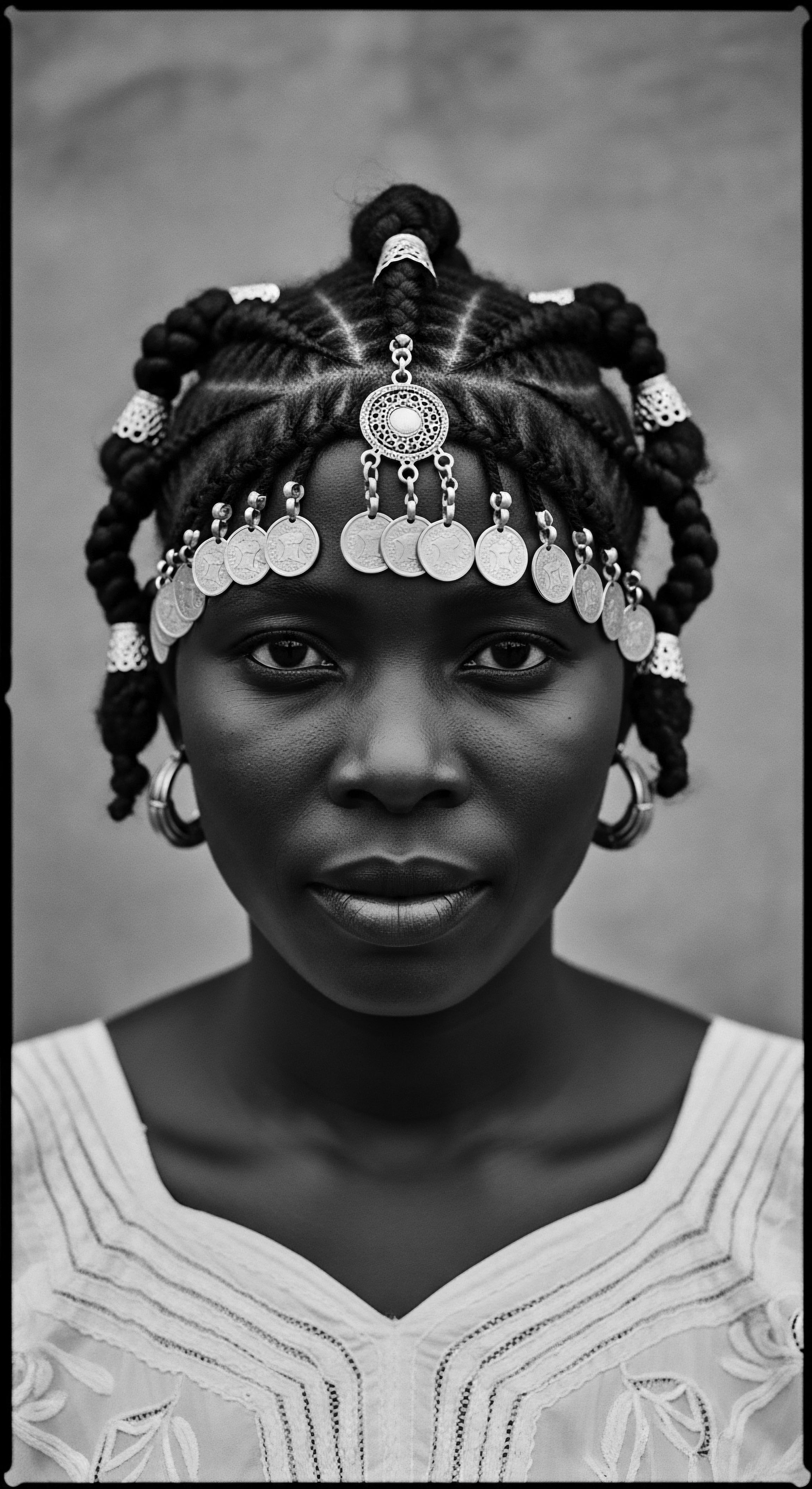
The Earth’s First Offerings ❉ Elemental Beginnings
Before the advent of complex formulations, humanity relied upon the unadulterated gifts of the natural world. These elemental beginnings form the bedrock of our understanding of Natural Hair Ingredients. The very ground beneath our feet yielded clays for cleansing and mineral-rich earth for fortification.
Trees provided butters and oils, their protective properties echoing the shelter they offered in the landscape. Even the sun and rain contributed, influencing the growth and potency of the botanicals gathered.
- Shea Butter ❉ A rich, creamy emollient extracted from the nuts of the African shea tree (Vitellaria paradoxa), shea butter has been a staple across West and East Africa for centuries. Its profound ability to seal in moisture and protect hair strands made it an indispensable ingredient for coily and kinky textures, particularly in arid climates.
- Coconut Oil ❉ Revered in tropical regions, the oil pressed from coconut meat has long served as a conditioning agent, known for its ability to penetrate the hair shaft and reduce protein loss. Its widespread application in various indigenous communities speaks to its enduring efficacy.
- Aloe Vera ❉ The succulent leaves of the aloe plant offered a cooling, soothing gel, utilized for centuries to calm irritated scalps and provide lightweight moisture. Its presence in traditional remedies spans continents, recognized for its gentle yet effective properties.
These primary ingredients, in their rawest forms, represented the direct response to hair’s needs, informed by centuries of observation and empirical wisdom. Their efficacy was not measured by scientific metrics as we understand them today, but by the tangible health and vitality they imparted to the hair, and the way they allowed textured hair to flourish in its natural state.
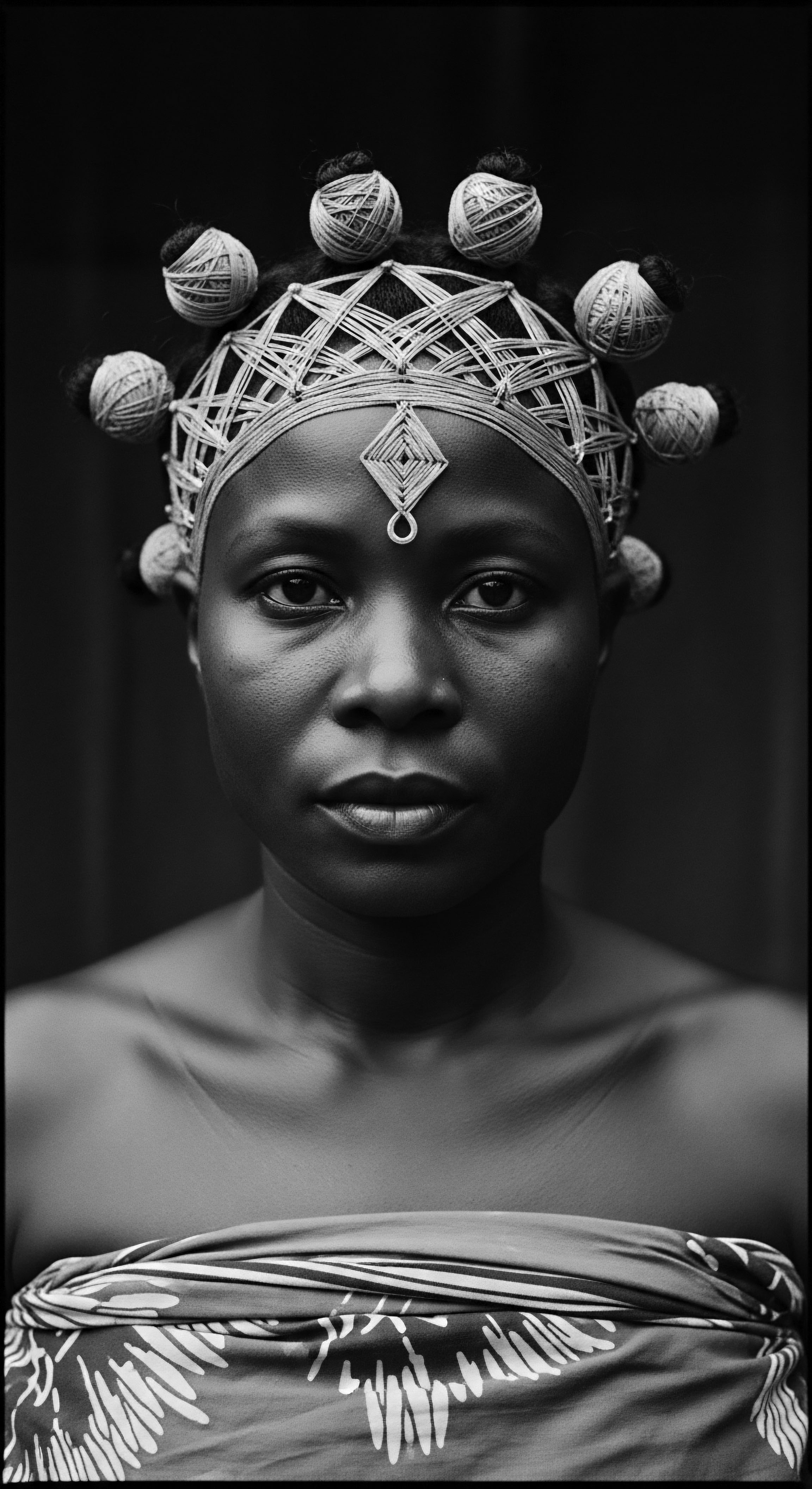
Ancestral Wisdom and Early Application
The earliest forms of hair care were intrinsically linked to the immediate environment and the plants that thrived within it. Ancestral communities developed sophisticated systems of knowledge, understanding the properties of local flora and fauna for various purposes, including hair maintenance. This knowledge, passed down through oral traditions and practical demonstration, constituted a living library of botanical remedies.
For instance, the use of certain barks for their cleansing properties, or specific leaves for their conditioning effects, became part of a communal rhythm. The rhythmic application of these ingredients during grooming sessions served not only a functional purpose but also a social one, fostering connection and the sharing of stories. This deep ancestral connection to the land and its resources meant that Natural Hair Ingredients were not merely commodities; they were sacred gifts, their collection and preparation often accompanied by rituals of respect and gratitude.
| Ingredient Chebe Powder |
| Traditional Region/Community Basara women of Chad |
| Primary Hair Benefit (Ancestral Understanding) Length retention, breakage reduction, moisture sealing |
| Ingredient Argan Oil |
| Traditional Region/Community Berber women of Morocco |
| Primary Hair Benefit (Ancestral Understanding) Softening, shine, protection from elements |
| Ingredient Baobab Oil |
| Traditional Region/Community Various West African communities |
| Primary Hair Benefit (Ancestral Understanding) Nourishment, elasticity, scalp health |
| Ingredient Hibiscus |
| Traditional Region/Community Parts of West Africa, India |
| Primary Hair Benefit (Ancestral Understanding) Strengthening, conditioning, stimulating growth |
| Ingredient These ingredients represent a fraction of the vast botanical knowledge passed down through generations, each offering unique benefits for the diverse expressions of textured hair. |
The deep reverence for these practices underscores the profound meaning embedded within Natural Hair Ingredients. They represent a continuum of care, a testament to human ingenuity in adapting to environmental conditions, and a celebration of the hair’s inherent beauty. This foundational understanding sets the stage for a deeper exploration of how these heritage practices continue to shape contemporary approaches to textured hair care.

Intermediate
Moving beyond the foundational echoes, the intermediate understanding of Natural Hair Ingredients invites us to consider how these heritage practices have been lovingly passed down and thoughtfully adapted across generations and geographies. This phase of comprehension reveals the dynamic vitality of ancestral wisdom, demonstrating how traditional knowledge surrounding Natural Hair Ingredients has not remained static, but has instead flowed like a nourishing river, carving new paths while sustaining its original source. For those with textured hair, this journey of continuity and adaptation is particularly poignant, reflecting the resilience of Black and mixed-race hair experiences through periods of profound change and cultural expression.
The significance of Natural Hair Ingredients, at this level, expands to encompass their practical applications within traditional and evolving hair care rituals. These are not just isolated elements; they are integral components of holistic systems of care that have shaped collective and individual identity. The transmission of these practices often occurred within the intimate confines of family, where mothers, aunts, and grandmothers imparted the sacred knowledge of mixing, applying, and styling with nature’s bounty. This hands-on pedagogy, steeped in cultural context, fostered a deep respect for the hair and its unique needs.
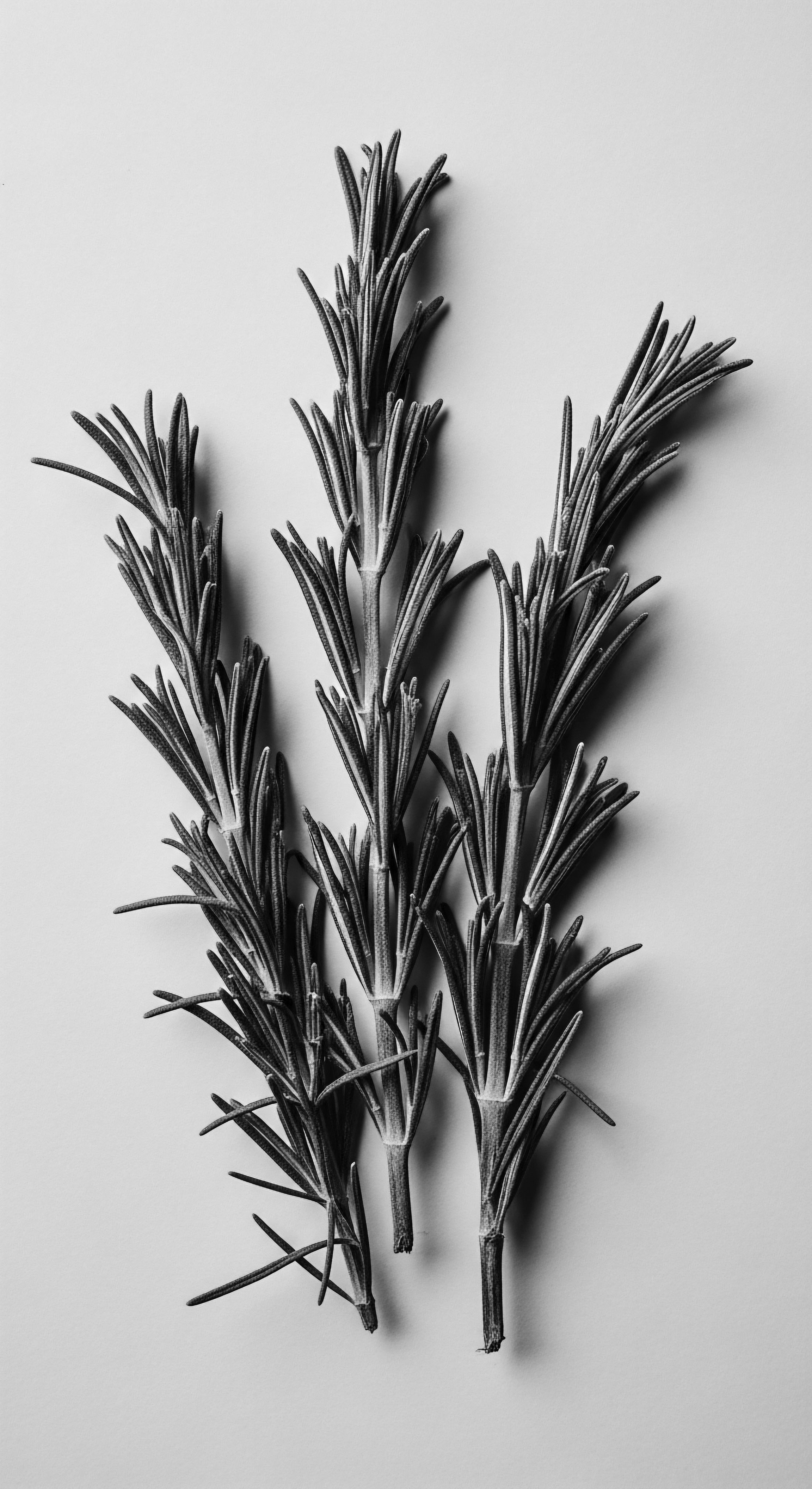
The Tender Thread ❉ Living Traditions of Care and Community
The heart of Natural Hair Ingredients’ enduring presence lies within the living traditions that have kept them relevant. These are the tender threads that connect past to present, community to individual, and spirit to strand. In many African and diasporic communities, hair care rituals involving natural ingredients were, and remain, deeply communal acts. The meticulous braiding, twisting, and oiling of hair served as moments for bonding, storytelling, and the reinforcement of cultural values.
The practical applications of Natural Hair Ingredients within traditional and evolving hair care rituals underscore the continuity and adaptation of heritage knowledge.
Consider the ritualistic use of specific oils and butters in West African traditions, where these emollients were applied to keep hair moisturized in hot, dry climates, often paired with protective styles to maintain length and health. This deliberate approach speaks to an inherent understanding of textured hair’s porosity and its need for sustained hydration. The very act of hair oiling, passed down through generations, became a ritual of care, nourishment, and a silent affirmation that healthy hair begins at the scalp.
- Palm Oil ❉ Beyond its culinary uses, various forms of palm oil, particularly red palm oil, were utilized in some West African traditions for their conditioning properties and ability to add a subtle sheen to hair, offering protection against environmental stressors.
- Castor Oil ❉ With roots in ancient African and Caribbean traditions, castor oil, particularly the darker, roasted variety known as Jamaican Black Castor Oil, has been prized for its viscosity and purported ability to support hair strength and thickness, especially for edges and scalp health.
- Fenugreek ❉ Seeds of this plant, soaked and ground, have been used in North African and South Asian hair care for their conditioning and strengthening qualities, believed to promote hair vitality and address thinning.
The continuity of these practices, even in the face of forced displacement and cultural disruption, is a testament to their intrinsic value. Enslaved Africans, for instance, carried knowledge of indigenous plants and hair care techniques across the Atlantic, adapting them to new environments and available resources. The braiding of rice seeds into hair for survival during the transatlantic slave trade, or the creation of maps through cornrows, powerfully illustrates how hair, and the ingredients used to tend it, became a profound tool of resistance and survival. This profound heritage is not merely historical anecdote; it is a living blueprint for contemporary textured hair care.
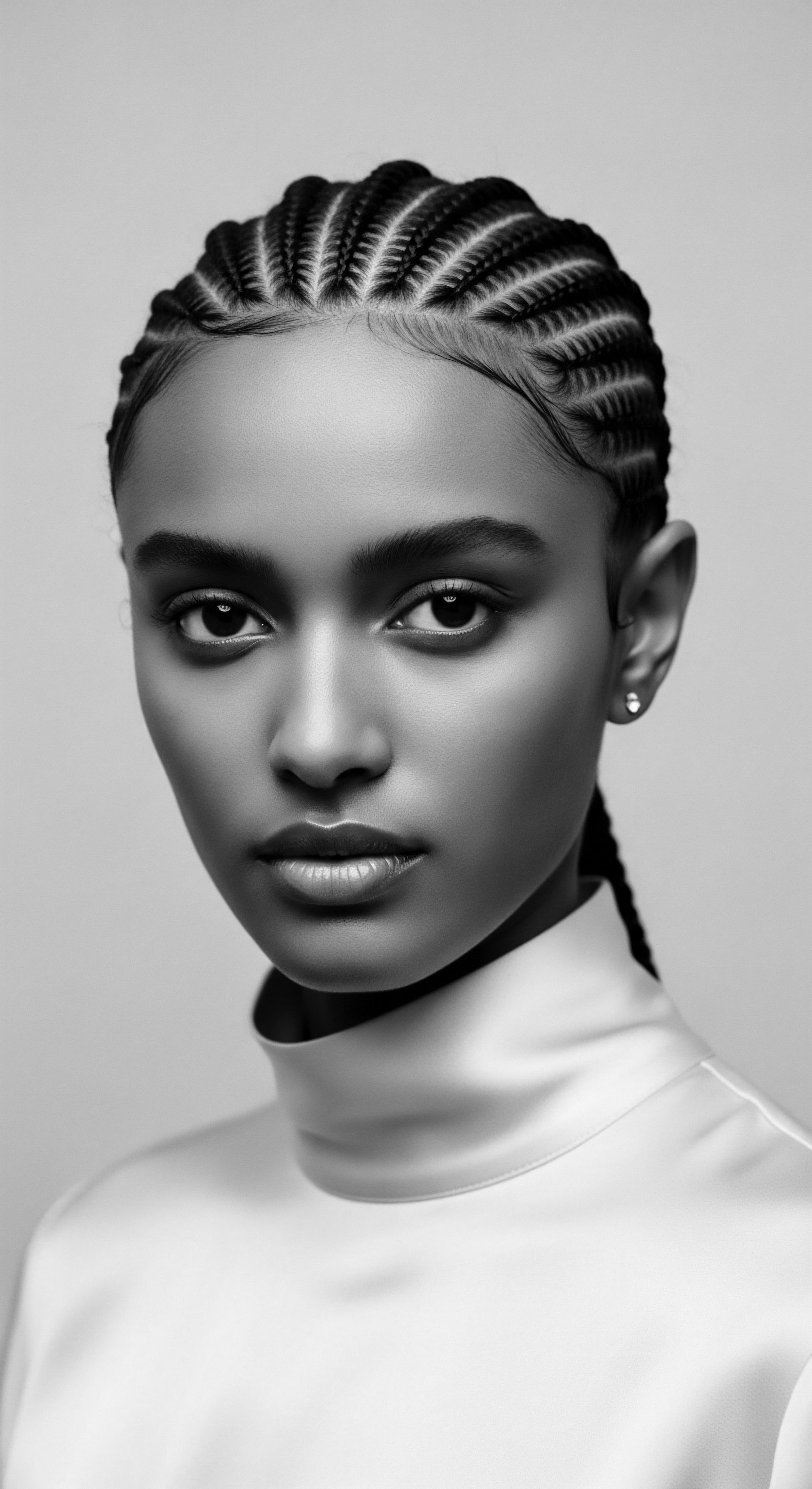
Adaptation and Evolution in Diasporic Practices
As Black and mixed-race communities navigated new landscapes, the traditional application of Natural Hair Ingredients evolved. The ancestral wisdom, though sometimes challenged by the scarcity of familiar plants or the imposition of foreign beauty standards, found ingenious ways to persist. New ingredients were discovered and incorporated, and traditional methods were adapted to suit new circumstances. This adaptive spirit ensured that the legacy of natural hair care continued to flourish, albeit in modified forms.
The emergence of the natural hair movement in recent decades has brought about a powerful resurgence and re-evaluation of these traditional practices. Individuals are actively seeking to reconnect with their heritage, turning to time-honored ingredients and methods that honor the inherent beauty of textured hair. This contemporary embrace is not simply a return to the past; it is a sophisticated re-engagement, where ancestral wisdom is validated and amplified by modern understanding.
| Historical Context Pre-colonial Africa |
| Traditional Application Direct plant extracts, fresh infusions, communal application |
| Contemporary Adaptation Formulations with plant-derived oils, butters, and extracts; individual self-care rituals |
| Historical Context Transatlantic Slave Trade/Diaspora |
| Traditional Application Adaptation of available botanicals, covert use for survival/identity |
| Contemporary Adaptation Re-discovery of indigenous ingredients, community-driven education, DIY formulations |
| Historical Context Modern Natural Hair Movement |
| Traditional Application Intentional return to traditional methods, blending with scientific understanding |
| Contemporary Adaptation Commercially available products featuring traditional ingredients, online communities sharing ancestral knowledge |
| Historical Context The journey of Natural Hair Ingredients reveals a continuous thread of resilience and ingenuity, adapting to new realities while preserving their foundational heritage. |
The meaning of Natural Hair Ingredients, therefore, is not confined to their biological composition alone. It is interwoven with the stories of survival, the celebration of cultural identity, and the ongoing dialogue between ancient practices and modern expressions of self-care. This intermediate perspective deepens our appreciation for the enduring power of these ingredients as conduits of heritage and tools for holistic wellbeing.

Academic
The advanced understanding and precise meaning of ‘Natural Hair Ingredients’ transcend simplistic definitions, arriving at a sophisticated delineation rooted in its profound connections to textured hair heritage, its ongoing evolution, and its rigorous scientific validation. From an academic perspective, Natural Hair Ingredients are not merely substances of natural origin; they represent a complex interplay of ethnobotanical knowledge, historical resilience, biochemical efficacy, and cultural semiotics. This advanced explication requires a multi-layered analysis, considering the theoretical frameworks of anthropology, the meticulous records of history, and the empirical validations of modern science, all converging to illuminate the profound significance of these elements within the narrative of Black, mixed-race, and diverse textured hair experiences.
The conceptualization of Natural Hair Ingredients, particularly for textured hair, necessitates an understanding of their deep-seated functional and symbolic roles. Functionally, these ingredients address the inherent structural characteristics of textured hair—its unique coil patterns, varying porosities, and susceptibility to moisture loss. Symbolically, they embody ancestral wisdom, cultural resistance, and the reclamation of indigenous beauty standards in a world often dominated by Eurocentric ideals. This compound insight reveals Natural Hair Ingredients as vital agents in fostering hair health, preserving cultural memory, and affirming identity.
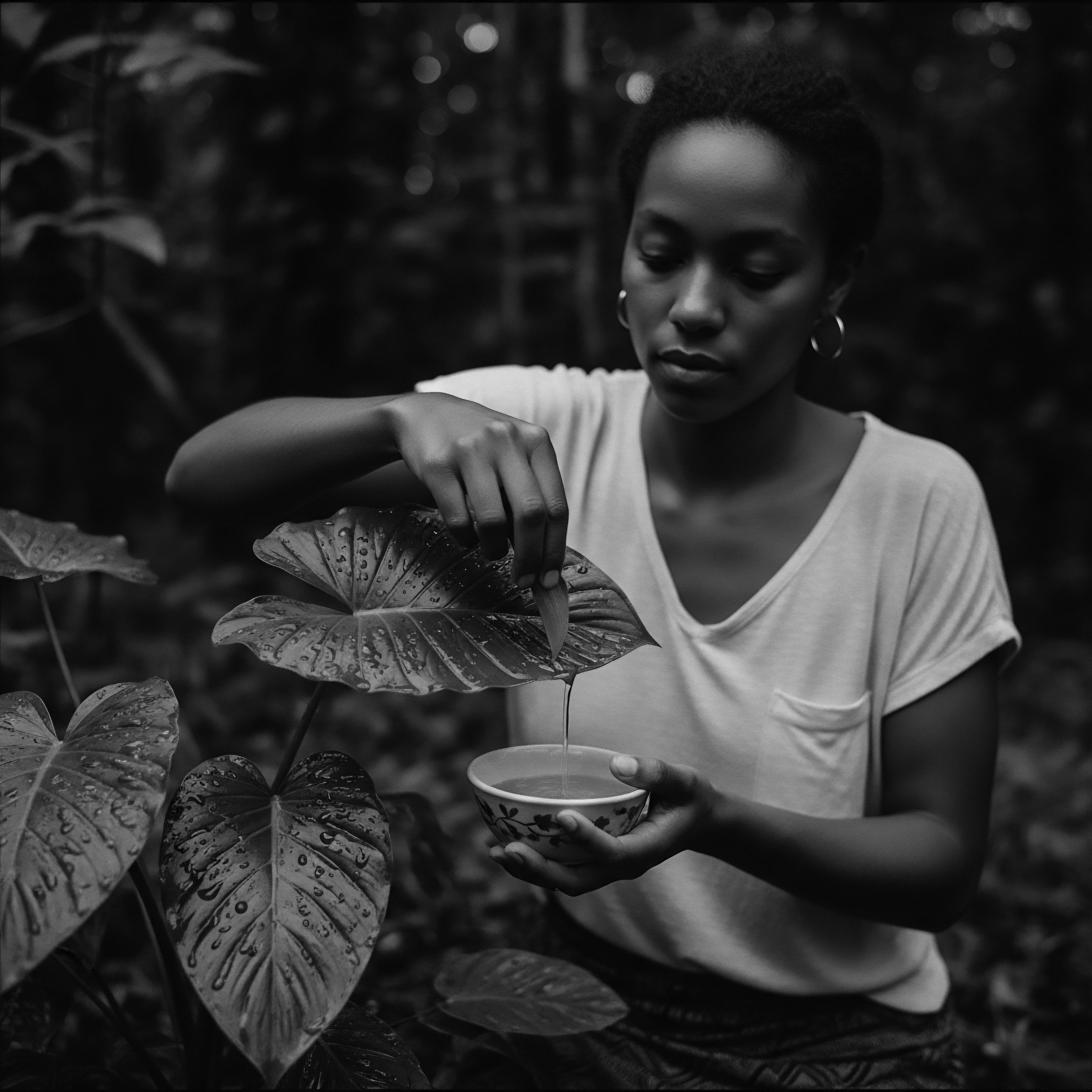
Anthropological Roots and Ethnobotanical Delineation
From an anthropological vantage point, Natural Hair Ingredients are artifacts of human-plant interaction, meticulously selected and utilized across millennia. Their identification and application within specific communities speak to sophisticated systems of traditional ecological knowledge. Ethnobotany, the study of the relationships between people and plants, provides the framework for understanding how indigenous populations, particularly in Africa, systematically identified, cultivated, and prepared botanicals for cosmetic and therapeutic purposes, including hair care.
The continued practice of hair oiling, for instance, represents an ancient ritual passed down through generations of African and South Asian women, utilizing oils like coconut, castor, and argan, often as a pre-wash ritual to maintain hair health and protect against damage. This is not incidental; it is a testament to an inherited understanding of hair’s biological needs.
The academic meaning of Natural Hair Ingredients encapsulates their complex roles as ethnobotanical artifacts, historical symbols of resilience, and biochemically effective agents for textured hair.
The significance of these ingredients extends beyond their immediate chemical composition to their embeddedness within social structures. The preparation of these ingredients, often a collective endeavor, reinforced community bonds and facilitated the intergenerational transfer of knowledge. The very act of applying these natural substances, whether in a communal setting or within a family unit, served as a pedagogical moment, transmitting not only technique but also cultural values and a deep reverence for one’s heritage.
One compelling case study that powerfully illuminates this connection to textured hair heritage is the use of Chebe Powder by the Basara women of Chad. This ancient practice, documented by researchers and increasingly recognized globally, involves a blend of natural herbs, seeds (primarily Croton zambesicus), and spices. The Basara women have, for centuries, applied this powder, mixed with oils and butters, to the lengths of their hair, meticulously coating strands and then braiding them into protective styles. The primary effect is not direct hair growth from the scalp, but rather a profound reduction in breakage and an enhancement of moisture retention, allowing the hair to reach remarkable lengths, often well beyond the waist.
This phenomenon, as observed by scholars and ethnographers, demonstrates a sophisticated, empirical understanding of hair mechanics ❉ by strengthening the hair shaft and minimizing environmental stressors, the Basara women effectively preserve length that would otherwise be lost to breakage (Bailey, as cited in Segal, 2021). The consistent application of Chebe powder, a weekly regimen for many Basara women, is a deeply ingrained cultural practice, symbolizing their identity and serving as a tangible link to their ancestral lineage. This is a potent example of how Natural Hair Ingredients, when understood through a heritage lens, reveal profound insights into long-term hair health and cultural preservation.
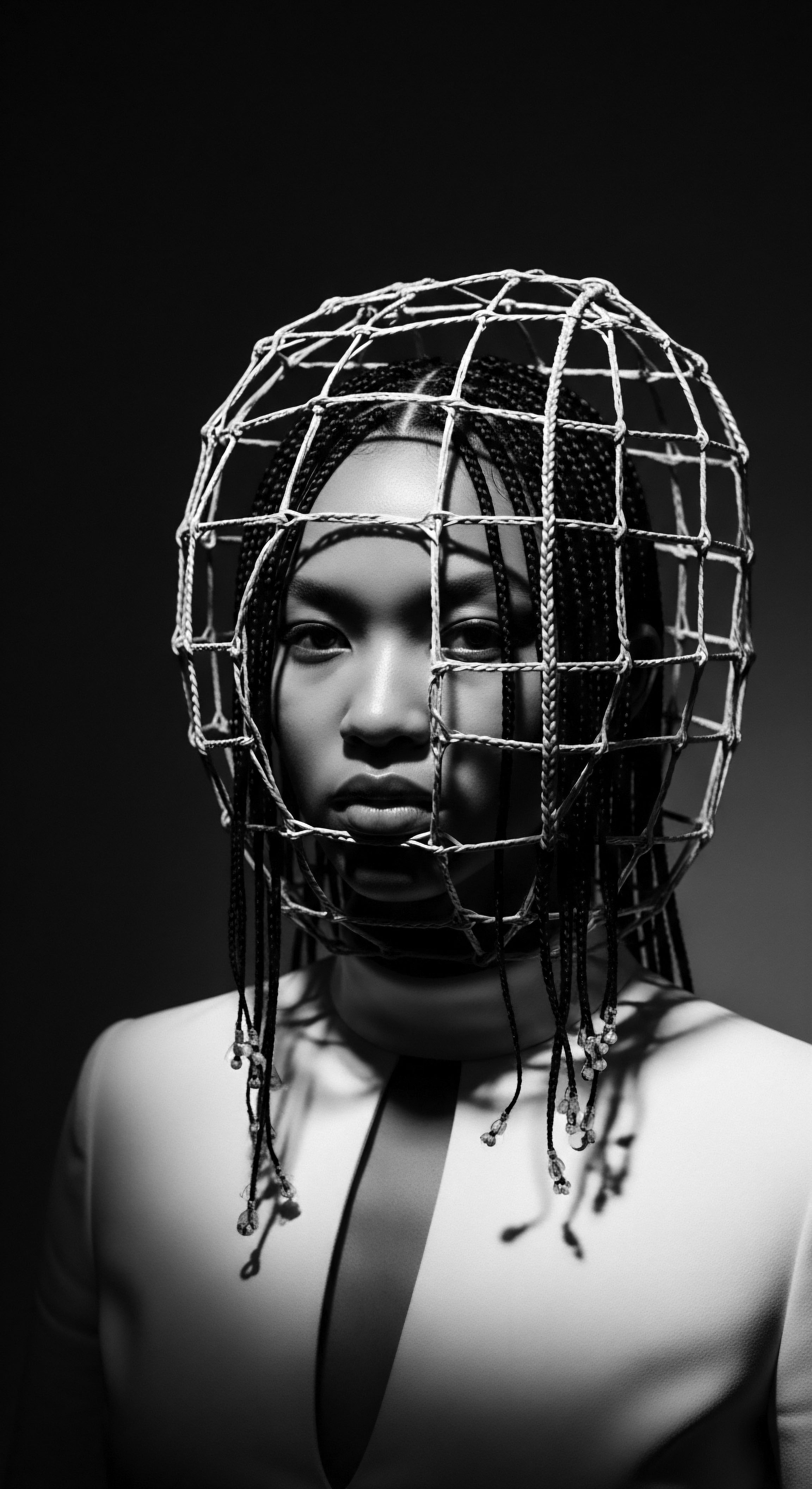
Biochemical Efficacy and Modern Validation
The scientific analysis of Natural Hair Ingredients often validates the long-standing traditional wisdom surrounding their use. Modern trichology and cosmetic science are increasingly exploring the biochemical profiles of these botanicals, identifying active compounds that contribute to their purported benefits. For instance, the fatty acid profiles of traditional oils like shea and coconut provide insights into their occlusive and penetrating properties, explaining their efficacy in moisturizing and protecting the hair shaft.
- Saponins from Sapindus Mukorossi (Soapnut) ❉ These natural surfactants, found in plants like soapnuts, have been used for centuries as gentle cleansing agents, offering an alternative to harsh chemical detergents, particularly beneficial for the delicate nature of textured hair.
- Mucilage from Flaxseeds ❉ When soaked, flaxseeds release a mucilaginous gel rich in polysaccharides, which provide natural hold and conditioning for curls and coils, enhancing definition without stiffness.
- Phytochemicals in African Botanicals ❉ Research is increasingly identifying diverse phytochemicals in African plants, such as those found in baobab or moringa, which possess antioxidant, anti-inflammatory, and nourishing properties, supporting both scalp health and hair strength.
The academic inquiry into Natural Hair Ingredients extends to understanding how their traditional preparation methods might influence their biochemical efficacy. Roasting or sun-drying certain seeds, for example, can alter their chemical composition, potentially enhancing the bioavailability of beneficial compounds or modifying their texture for optimal application. This nuanced understanding bridges the gap between ancestral empirical observation and contemporary scientific validation.

Socio-Economic and Cultural Implications
Beyond their direct application, Natural Hair Ingredients carry significant socio-economic and cultural implications. The global natural hair movement has led to a resurgence in demand for these traditional ingredients, creating new markets and opportunities for communities that have historically cultivated and utilized them. However, this increased demand also raises important questions about ethical sourcing, fair trade, and the potential for cultural appropriation.
From an expert perspective, the long-term success of the Natural Hair Ingredients sector, particularly as it relates to textured hair, hinges upon a respectful and reciprocal relationship with the communities from which this knowledge originates. This involves ensuring that the economic benefits flow back to the traditional custodians of this wisdom and that their practices are honored and protected. The corporate and advanced perspective on Natural Hair Ingredients must therefore consider not just product development, but also community development, ensuring sustainable practices and equitable partnerships.
This requires a shift from mere extraction to genuine collaboration, where ancestral insights are valued as intellectual property and cultural treasures. The ongoing dialogue surrounding these ingredients serves as a powerful reminder that true progress involves honoring the past while building an equitable future.

Reflection on the Heritage of Natural Hair Ingredients
The journey through the intricate world of Natural Hair Ingredients is, at its heart, a profound meditation on textured hair, its heritage, and its care. It is a narrative that speaks not only of botanical compounds and their actions but of human resilience, cultural ingenuity, and the enduring connection to the earth. From the whispers of ancient practices, where plants were sacred gifts, to the vibrant affirmations of identity in contemporary movements, these ingredients serve as more than mere substances; they are living archives, each leaf, seed, and root holding stories of survival, beauty, and profound wisdom.
The ‘Soul of a Strand’ ethos finds its deepest resonance in this exploration. Every coil, every kink, every wave carries within it the memory of hands that nurtured it with ancestral oils, of communities that celebrated its natural form, and of spirits that refused to be diminished. The deliberate choice to honor Natural Hair Ingredients is a conscious act of reaching back through time, grasping the tender thread of heritage, and weaving it into the fabric of present-day self-care. It is a recognition that the health of our hair is inextricably linked to the health of our history, and that true wellness blooms when we cultivate both with reverence.
The journey of Natural Hair Ingredients is a profound meditation on textured hair’s heritage, revealing how botanical elements embody resilience, cultural ingenuity, and a deep connection to ancestral wisdom.
The significance of Natural Hair Ingredients will continue to evolve, yet its core meaning, grounded in heritage, will remain steadfast. As we move forward, the challenge and the opportunity lie in fostering a deeper, more equitable appreciation for these gifts. It involves supporting ethical sourcing, championing the knowledge of indigenous communities, and educating new generations about the profound legacy embedded within each natural element. This ongoing commitment ensures that the living library of Roothea continues to expand, not just with information, but with the vibrant, breathing spirit of textured hair heritage, guiding us toward a future where every strand tells a story of unbound beauty and ancestral pride.

References
- Bailey, A. (2021). As cited in Segal, L. (2021, August 10). What Is Chebe Powder, and Can it Really Help With Hair Growth? Harper’s Bazaar .
- Fongnzossie, E. F. & Tsabang, N. (2018). Herbal Cosmetics Knowledge of Arab-Choa and Kotoko Ethnic Groups in the Semi-Arid Areas of Far North Cameroon ❉ Ethnobotanical Assessment and Phytochemical Review. MDPI .
- Khan, S. A. Singh, V. & Ahmad, S. (2023). Ethnobotanical Advancements in Contemporary Skincare. In Ethnobotany ❉ Traditional Knowledge and Modern Applications (pp. 13-30). IGI Global.
- Mohamed, H. A. (2024). Cosmetopoeia of African Plants in Hair Treatment and Care ❉ Topical Nutrition and the Antidiabetic Connection? Diversity, 16(2), 96.
- Ripa Ajmera, A. (2022). The Way of the Goddess ❉ Daily Rituals to Awaken Your Inner Warrior and Discover Your True Self .
- Segal, L. (2021, August 10). What Is Chebe Powder, and Can it Really Help With Hair Growth? Harper’s Bazaar .
- Sharma, S. & Singh, R. (2024). Hair oiling ❉ a paradigm shift in the deep-rooted ritual from East to West. British Journal of Dermatology .
- Taylor, J. (2021). As cited in Segal, L. (2021, August 10). What Is Chebe Powder, and Can it Really Help With Hair Growth? Harper’s Bazaar .
